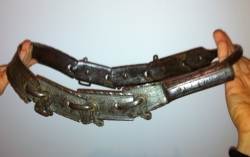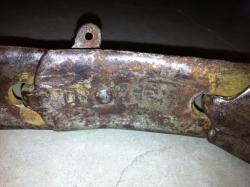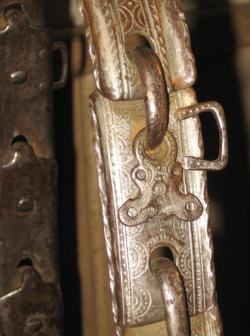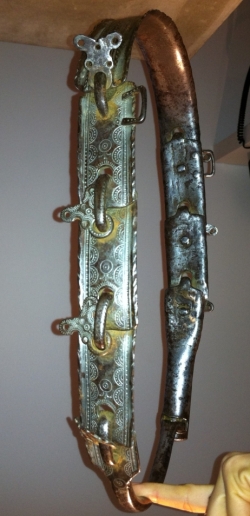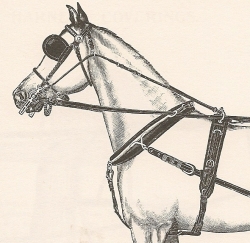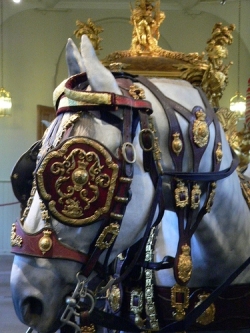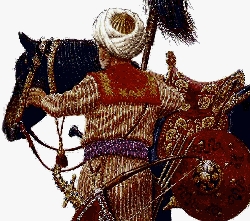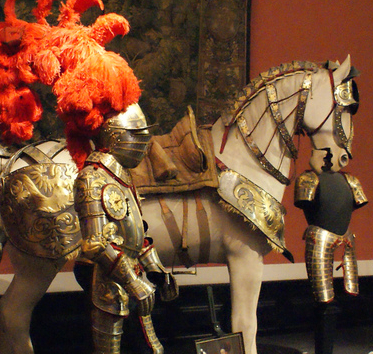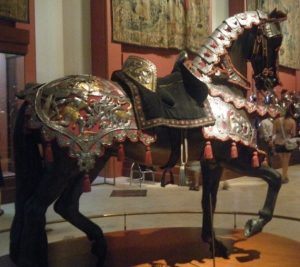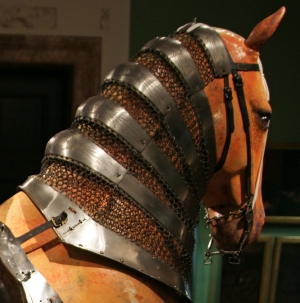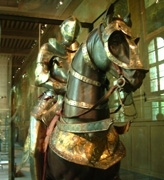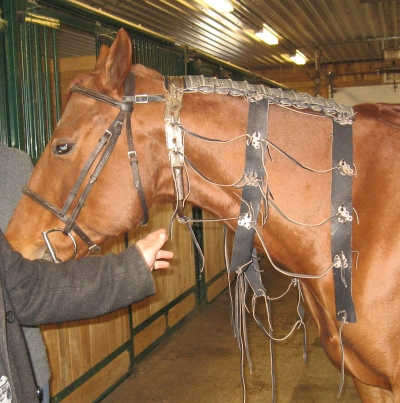Home > Horse Barding > Horse Armor
An evaluation of a piece of horse armor.
by Joyce Mueller
This picture appeared in my email one day. The owner had purchased it from a dealer in European antiques and was told it was a belt for a harem slave girl. Another person thought it was for a horse. They asked my opinion.
Thus began a minor obsession. I spent hours examining the pictures and searching the internet and books for anything similar. Later I had an opportunity to examine the piece in person. This article is a cronicle of my journey to find answers.
Before determining who or what it was used on, first I had to see how it was used. For that I needed to listen to the piece's story.
Questions to ask: What is the design? How was it manufactured? What was it made of? How is it decorated? Are there distinguishing marks? What are the wear patterns?
What is the design?
The piece consists of a number of metal plates riveted together allowing for articulation. There is a solid curved plate on one side and a two piece closure on the other. There are a number of smaller medallions dangling from the articulating points.
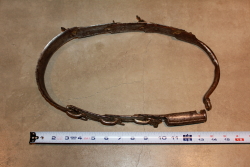 The resting shape is roughly oval. The piece is closed together by sliding the smooth section into the slot of the second section and a third piece (now missing), a pin, would lock the two ends together. Diameter length is about 14”. Approximate circumference is 30”-34”. Width of the sections is about 1 1/2”.
The resting shape is roughly oval. The piece is closed together by sliding the smooth section into the slot of the second section and a third piece (now missing), a pin, would lock the two ends together. Diameter length is about 14”. Approximate circumference is 30”-34”. Width of the sections is about 1 1/2”.
The short curved ends are solid while the long sides have some flexion. The articulating sections would allow expansion for placing onto an object, but the overall piece would not be adjustable.
How was it manufactured?
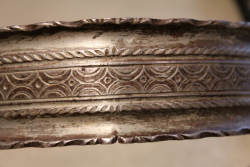 There are two ways it might have been manufactured. The more modern way would be to “coin” the sections. In this process a template was made with a design and the pieces would be cut, stamped, and shaped in a mass produced manner. The other way would be if each section was individually made. An easy way to determine which method was used is if the sections would be examined for pattern irregularities. If the irregularities occur equally on multiple sections, they were probably coined. Upon closer examination I noted that there are several areas on the crown piece where the half-circle stamps overlap, and some areas on the shorter sections where the pattern deviates between pieces. This suggests the piece was made by hand.
There are two ways it might have been manufactured. The more modern way would be to “coin” the sections. In this process a template was made with a design and the pieces would be cut, stamped, and shaped in a mass produced manner. The other way would be if each section was individually made. An easy way to determine which method was used is if the sections would be examined for pattern irregularities. If the irregularities occur equally on multiple sections, they were probably coined. Upon closer examination I noted that there are several areas on the crown piece where the half-circle stamps overlap, and some areas on the shorter sections where the pattern deviates between pieces. This suggests the piece was made by hand.
The articulation of the piece is accomplished by rods being welded to one end of the section. The rod is then bent and passed through the hole of the next section where a triangular shaped medallion is added. Then the rod is bent back through a hole in the original section and peened into place.
What was it made of?
The piece is metallic. A magnet sticks to it, so the base metal is ferrous. There are also signs of rusting on places that show wear. A bluish patina covers the outside of the piece, fading away in areas of wear. There is no rust in the bluish areas. This leads me to believe the piece was silver plated. There are areas on the inside that show a brass coloration, possibly due to brass welding.
How is it decorated?
The stamping pattern has a geometric format. If hand stamped, the half-moon section could be done with a creaser, two half circle stamps and a punch. The triangle medallions are made with a series of punched out circles and a creaser. The marks are very fine but quite visible.
Are there distinguishing marks?
 There are several marks on one part of the closing section. The three marks to the left are “maker's marks” and could stand for the designer, the artist working on it, or the metal content. They would be placed on the piece with a stamp. Part of the marks may be deeper and parts may be missing because the stamps were flat but the section is rounded. Compare the stamps to the crisp lines of the numbers, which were chiseled in. The same chisel was used for all the numbers, but was angled or rotated when struck to give different results.
There are several marks on one part of the closing section. The three marks to the left are “maker's marks” and could stand for the designer, the artist working on it, or the metal content. They would be placed on the piece with a stamp. Part of the marks may be deeper and parts may be missing because the stamps were flat but the section is rounded. Compare the stamps to the crisp lines of the numbers, which were chiseled in. The same chisel was used for all the numbers, but was angled or rotated when struck to give different results.
It is easy to assume that the numbers stand for the year 1794. It is also possible that the number has some other significance such as an item number or numbering for a corresponding set. Without corroborating evidence, no assumptions can be made.
I do not have much experience with maker's marks, but having 3 stamps might indicate that the piece was either important or was silver plated. The owner's sources thought the font of the L was similar to a mark referenced to the Netherlands.
What are the wear patterns?
The piece tells us a little of the story of its life by how worn it is. Whatever job it did, it was used a lot and meant to be used under stress.
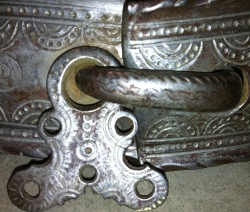 The medallions caused wear on the rod where they fasten back to the original section. We can also see that the most wear on the medallions is on the upper edge of the hole. These clues suggests that the medallion hung down to the left instead of in its current position. This would also keep it from interfering with the articulation, as it would bind up in the piece if it hung as shown or to the right.
The medallions caused wear on the rod where they fasten back to the original section. We can also see that the most wear on the medallions is on the upper edge of the hole. These clues suggests that the medallion hung down to the left instead of in its current position. This would also keep it from interfering with the articulation, as it would bind up in the piece if it hung as shown or to the right.
Upon closer examination the medallions show wear patterns in some of the outer holes.This suggests they were useful as well as decorative. A fine chain or a small rivet for a leather strap could have been attached here.
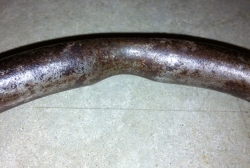 This section of the closing pieces is quite plain and undecorated, nothing more than round metal stock. In the center of the section is a spot of significant wear, primarily on the inside of the curve and somewhat on the sides of the curve. This indicates a connection with an unknown piece which resulted in a swinging motion. The lack of decoration also indicates this section was in a position where it was not generally seen.
This section of the closing pieces is quite plain and undecorated, nothing more than round metal stock. In the center of the section is a spot of significant wear, primarily on the inside of the curve and somewhat on the sides of the curve. This indicates a connection with an unknown piece which resulted in a swinging motion. The lack of decoration also indicates this section was in a position where it was not generally seen.
Conclusions:
This photo was taken holding the piece at the wear point shown above. But we can see if this happens that the medallions hang in a manner where the decoration disappears. So I have inverted the photo to show the position in which I feel the piece actually was used.
This photo brings up other details that were not well seen in the earlier photos. We see a consistent pattern of wear on the half-moon “crown” section. And there are decorated bars welded onto the two sections just below the crown, suggesting a leather strap was attached to each side.
Possible Uses:
Human: Because anything worn by a human would have to hang in a horizontal fashion, and this piece hangs in a vertical fashion, we can conclude that it was not worn by a human, in a harem or otherwise.
Inanimate objects: If this piece had a purpose, it most likely would have been used in an application where it surrounded an oval object, or a series of circular objects, binding them together. There may have been another object (such as a lantern) which hung from it. However, in my searches I have not found such an application yet. Also, if it hung high to hold a lantern that does not explain why the crown, which would be out of sight, is decorated while the bottom, which would be visible, is plain.I am not satisfied with this possibility.
Horse: There are only two places this piece might have fit on a horse or pony. The first would be around the girth, the center of the horse just behind the front leg. The piece is too small for a horse, but could it have fit a pony, perhaps as part of a driving harness? A surcingle is used in that area. The problem is that the pony's ribs expand and contract while breathing, and anything placed in this area needs to have some stretchability. Most girths are of leather and are adjustable. But while our piece has some degree of movement, it is not designed to “give” and has no adjustment for size. Also, if anything would hang from the bottom to produce the wear we see in our piece, it would interfere with the pony's legs. I do not think it was used in this way.
The other place the piece might fit would be on the horse's neck. Some harnesses have collars, and on these collars are “hames”, wooden or metal arms which keep the shape of the collar while in use. Hames are solid on the sides to allow the horse's shoulder to “push” against the harness, while the top and bottom are flexible to allow for adjustment and movement of the horse. Our piece is just the opposite, flexible on the sides and solid on the top and bottom. I do not think this piece was used as part of a horse collar.
But this piece might also fit on the top of the horse's neck, just behind the head. The size would be about right, 32”-34” and there is no need for adjusting. The oval shape of the neck is the same as our piece. The piece would hang vertically, in the correct position. The crown, which would be visible, is decorated, while the plain bar on the bottom would be hidden in the fold of the throatlatch. An object hanging from the bottom would not interfere with the action of the horse. The areas for leather straps near the top would allow the piece to be attached to the bridle of the horse. The articulation of the piece would allow it to be placed onto the neck. Even the position of the pin for the closing pieces is located on the left side of the horse, the side horses are traditionally worked on.
To find a new piece of horse tack that has never been seen before is very exciting.
On the other hand, if it's never been seen before, is that really what it is?
I have been studying horses and tack for a very long time and have not seen a piece of this type used in this manner.
In some driving harnesses there is an attachment to the bridle which keeps the reins or check-reins out of the way, but they are usually shorter and don't go all the way around the horse's neck.
Mosemans' Illustrated Catalog of Horse Furnishing Goods
And many harnesses use brass rather than silver.
Royal British Bridle, Google Images
Some Eastern cultures hung tassles on straps around horse's necks, mostly made of cloth or leather. And the decoration was quite different, ranging from animal figures to swirling patterns. But they aren't that similar to this piece.
Turkic horse and rider 1683, Google Images
Then one day I saw this picture taken by Racaire in an Austrian Museum....
Everything fit. The piece is most likely part of a crinet, horse armor that protects the neck of the horse. This piece would be the first section of nine to eleven others, two of which also encircle the neck. The medallions are connected to each other with fine chains or leather straps.
http://www.flickr.com/photos/racaire/4611181971/in/set-72157624071259930/
There are many ways of attaching a crinet to the horse. In this photo of Maximillian's horse's armor we see a single metal strap low on the neck.
Photo from Google Images
In this photo we see a series of metal bands with chain mail in between.
Photo from Google Images.
This French armor also has bands, too bad we can't see the rest of the crinet.
Photo from Google Images.
Where to go from here?
The photo from Racaire's visit to an Austrian museum makes me feel fairly certain that this is what the piece was used for. However, there are a number of questions still existing:
- The makers marks need more study. If the artist or manufacturer can be found, then a date of production could be established.
- Although it is very similar to the Austrian armor, the decorations are very different. Austrians and Germans used lots of plumy feathery designs rather than the geometrics of our piece. A rough guess is the piece probably originated farther west, perhaps England or Spain.
- If the number is a date, then that is quite late for armor. Plate armor fell out of fashion when guns began to be used for warfare. If that is the date then the piece was most likely used for parades or special occasions.
Testing Theories:
The owner of the piece, Steve, was kind enough to allow me to see and test the piece. We met at a stable, where we discussed my conclusions. We then tried the piece on a 15.2 hand horse, and it fit perfectly, with over an inch of distance between the bottom bar and the neck.
Steve has more knowlege of medieval locks than I do. He told me the lock on this piece is what is known as a spring wedge lock, used from early Roman to Medieval times. The missing pin would have had two spring arms which expand when inserted, preventing the pin from coming back out. The "key" was inserted through a slot in the other end and exactly fit the shape of the wedge arms, squeezing them back together so the pin could slide back out. The key was very presice for each individual lock. These locks were often used on slave collars or to protect valuable items.
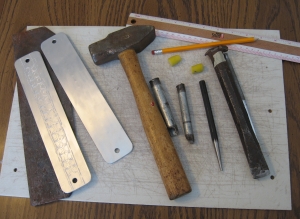
I then shaped them on a block form and laced them together over a leather support.
I created the medallions by punching a series of holes in 12 oz leather, cutting away the excess areas, recasing the leather after decorating, and baking the pieces in an oven at 175 degrees for about a half hour, checking every 5 minutes for hardness. When I saw the actual piece, I was amazed how thin, small and strong the medallions were.
Since I was running out of time, I used leather strapping to recreate where the other "belt" pieces would have gone. Here is a picture of what I created on a horse with the original piece beside it. You can see how much more refined the original piece is. I would have liked to have had some extra time to play with adjusting the pieces, but at least this gives an idea of what it might have looked like.
Final note:
This piece was showcased on Steve's Canadian cable TV show "Deals from the Dark Side" Episode 11, The Harem Belt. While the time allotted to the belt was short, it does show us placing the piece on a live horse. My thanks to Steve for bringing this piece to my attention and giving this recreator a chance to handle and personally examine a real treasure!
It's really awesome when you find
a piece of horse equipment
that few people have seen before!
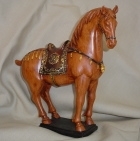 Medieval Horse and Clothing
Medieval Horse and Clothing